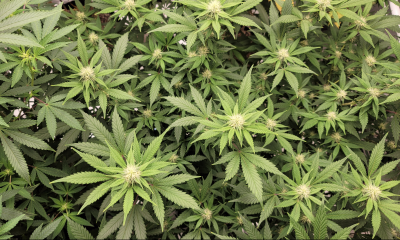Science & Health
New Study Shows How Marijuana Compounds Like Cannabinoids, Terpenes And Flavonoids Interact For Medical Benefits

A new scientific literature review published in the journal Molecules explores the “collaborative interactions” of various chemical compounds in marijuana—including cannabinoids, terpenes and flavonoids—arguing that a better understanding of the components’ combined effects “is crucial for unraveling cannabis’s complete therapeutic potential.”
The findings reinforce what many in the marijuana space have been saying for years: that it’s not only THC and CBD that modulate a person’s cannabis experience, but also the complicated interactions between cannabinoids, terpenes, flavonoids and other molecules in the plant—a concept known as the “entourage effect.”
“In cannabis science, cannabinoids, terpenes, and flavonoids have often been overlooked, with much of the literature focusing predominantly on the major cannabinoids THC and CBD,” said the seven-author research team behind the new study. “However, emerging evidence suggests that these constituents, particularly cannabinoids and terpenes, play a substantial role in interacting and collaborating. This interplay gives rise to the diverse effects, benefits, and side effects observed among different cannabis strains, which can vary in the ratios of these components.”
The new study, published last month, says that only by examining such nuanced interactions can researchers “unlock cannabis’s full therapeutic potential within the realm of natural plant-based medicine.”
Paying closer attention to distinct ratios of cannabinoids, terpenes and flavonoids in specific cannabis strains or products, for example, “can pave the way for developing more personalized and productive medicinal interventions.”
“Understanding the intricate interplay between cannabinoids, terpenes, and flavonoids is paramount for realizing the full therapeutic benefits of cannabis.”
Cannabinoids and terpenes, the researchers said, “both interact with the endocannabinoid system and exert various effects on the body, including analgesic, anti-inflammatory, and neuroprotective actions. However, it is becoming increasingly clear that their effects are not solely attributed to their actions but are modulated by other compounds in the plant.”
For instance, terpenes “have been shown to have pharmacological properties and can interact with neurotransmitter receptors, enzymes, and cell membranes, among other targets,” the study says, but they can also “influence the pharmocokinetics and pharmacodynamics of cannabinoids, potentially enhancing or modulating their effects.”
“The concept of the entourage effect suggests that the combined action of cannabinoids and terpenes may result in a synergistic or additive therapeutic effect greater than the sum of their individual effects,” it continues.
And while research into another class of compounds, flavonoids, is relatively limited, authors noted that “studies have suggested their anti-inflammatory, antioxident, and neuroprotective properties.” And some specific flavonoids, such as cannflavins, “have shown potent anti-inflammatory effects, particularly in neuroinflammation.”
The study provides a better picture of the complex web of chemical interactions that might influence marijuana’s effects on a person, but authors emphasized that “elucidating the synergistic effects and underlying mechanisms of cannabinoids, terpenes, and flavonoids demands a focused investigation.”
“Exploring these compounds’ biosynthesis, bioactivities, and biotechnological applications is pivotal for harnessing their therapeutic potential and diversifying treatment options,” they added, identifying a number of apparent gaps in research that warrant further study.
At the same time, the paper acknowledges that research into the federally controlled substance remains a major challenge.
“Addressing regulatory barriers obstructing cannabis research is imperative,” it says. “Overcoming these obstacles, stemming from the classification of cannabis as a Schedule I substance, is crucial to expanding access to cannabis products for research purposes. Furthermore, this would enable a more comprehensive exploration of the therapeutic and adverse effects of cannabis and cannabinoids, fostering informed decision making in public health initiatives.”
“A comprehensive exploration of the synergies between cannabinoids, terpenes, and flavonoids, coupled with advancements in phytochemical research and the removal of regulatory barriers, holds the key to unlocking the full therapeutic potential of cannabis.”
While a recent review by the Department of Health and Human Services concluded that marijuana should be moved to Schedule III of the Controlled Substances Act (CSA), the department initially kept its reasoning secret, waiting months before publicly releasing a justification for the proposal.
Research has nevertheless ticked up amid the growing legalization movement. According to analysis by the advocacy group NORML, scientists have published more than 32,000 marijuana studies over the past decade, with some recent years setting records for research.
While much of that research has focused on the effects of cannabis consumption, some studies have tried dig into the fundamental chemistry of cannabis. Just last year, for example, scientists discovered “previously unidentified cannabis compounds” called flavorants that are responsible for the unique aromas of different varieties of marijuana. Previously, many thought terpenes alone were responsible for various smells produced by the plant.
And since the end of the federal prohibition of hemp, research into the low-THC form of cannabis has also stepped up. Last year the U.S. Department of Agriculture (USDA) published guidance on how to identify, describe and evaluate different varieties of the plant as officials work to rebuild a government seed bank that was destroyed during prohibition. The department also posted a video instructing hemp farmers on how to build and use a Ghostbusters-like backpack vacuum, which USDA says can collect up to 10 grams of cannabis pollen in less than a minute.
Last October, meanwhile, USDA approved a genetically modified form of hemp to be grown and bred in the country. The variant was genetically engineered to produce lower levels of the cannabinoids THC and cannabichromene (CBC).
In terms of the entourage effect, a separate study last year found that cannabis products with a more diverse array of natural cannabinoids produced a stronger psychoactive experience in participants that lasted longer than the high generated by pure THC.
A 2018 study, meanwhile, found that patients suffering from epilepsy experience better health outcomes—with fewer adverse side effects—when they use plant-based CBD extracts compared to “purified” CBD products.
















